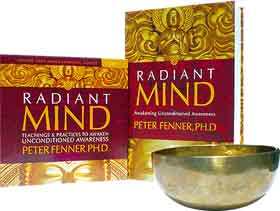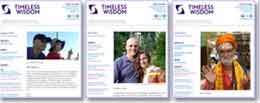Although people desire the non-dualistic and limitless (awareness, they make a) limit out of that which is not limited and thereby constrict the essential mind itself. Even though people desire (the realization of) both (the transcendent and relative) realities they fall into an extreme understanding of these. Although they desire the union of the two realities this is not the way things naturally are. No matter in what way you think about this you are trapped in the cage of (conflicting) desires.
Longchenpa
Throughout the ages spiritual masters and sage philosophers have pointed to a limitless, tran- scendent mystical reality by contrasting this with the limited, deceptive, and impermanent reality that we experience through our senses. Amongst other names, this mystical reality has been called the Godhead, Brahman, Tao, Source and Emptiness. However, according to the Dzogchen or Com- plete Fulfillment tradition, these realities are limited to the very same extent that they are distin- guished from that which is limited. In other words, as soon as limitlessness displaces that which is limited it assumes its own limits and restrictions.
In the above lines, the famous fourteenth century Tibetan master, Longchenpa, cautions people against limiting themselves by becoming fixated on the limitlessness of the mind itself. By distin- guishing the nature of the mind itself as being fundamentally different from mental phenomena, such as thoughts and feelings, people can become intellectually and philosophically captivated by the “idea” that the mind is limitless. But in so doing they fall into a fixed and extreme understanding of the Complete Fulfillment perspective. The Chinese Zen master Foyan makes the same point about Zen when he writes that, “You shouldn’t set up limits in boundless openness, but if you set up limitlessness as boundless openness, you’ve trapped yourself.”
This type of fixation is based on making a distinction between appearance and Reality. In orthodox Buddhism and mystical philosophies such as Hindu Advaita Vedanta, this distinction has been formalized in a theory of two levels of reality, the social or relative and the transcendent level. The relative reality corresponds to the world that is known through our body and mind. The tran- scendent reality corresponds to an open, unmarked and insubstantial reality that underlies the exist- ence of everything.
In terms of our spiritual development, knowledge of the relative reality primarily refers to understanding the consequences of being embodied. As a practice this involves understanding the inner dynamics, wherein our physical, verbal and mental behavior conditions what we experience in the future. In Indian spiritual systems this is called “understanding the workings of karma”. Through this practice we can gain skill in modifying our actions so that we consistently create opportunities for on-going spiritual practice. The implementation of these behavioral changes occurs mainly in the interpersonal arena. As such, an appreciation of the relative reality is mainly cultivated outside of formal sitting meditation. In contrast, an understanding of the transcendent reality is gained mainly through formal medi- tation practice during which one generates an unalloyed experience of an insubstantial voidness. While these contemplations begin with an empirical content, as soon as meditators see the inherent voidness of their object of contemplation, they let any imagery recede from their awareness, so that they can focus single-pointedly on the emerging experience of a formless, transcendent reality. In Buddhist traditions this is called generating a “space-like equipoise”. The rationale behind structur- ing their practice in this way is that one can produce deeper and more pure realization of the ultimate reality by focusing on a vacuous experience that is uncontaminated by any thoughts, feelings or sensory images. This type of meditation practice requires tremendous concentration and control in order to break through the seeming solidity and reality of our thoughts, feelings and perceptions. The downside in pursuing the realization of the transcendent and relative realities independently of each other is that they then need to be integrated into a way of being that seemlessly blends the freedom of unconditioned awareness with the complexities of living in a conditioned world. Tradi- tionally this is done in two different ways. Firstly, when meditators arise from their formal sitting practice they cultivate seeing things as though they are an illusion. In this way they attempt to directly suffuse their appreciation of phenomena with the experience of insubstantiality. Then within their space-like meditations on the transcendent level they will begin to allow objects such as thoughts and feelings to remain in their awareness alongside the emerging experience of the tran- scendent realm. In time the experience of the empirical and the transcendent become inseparable-one cannot be had without the other.
A further consequence of this way of practicing is that people can over-emphasize one or other of the two realities, and thus be led into a distorted spiritual path. For example, if someone cultivates an experience of transcendence but fails to appreciate how their thoughts, speech and physical behavior influences what they will experience in the future, they can easily lose touch with empirical world. They might become completely spaced out and lose their ability to operate safely and effec- tively in the physical world. This is called erring to the nihilist extreme and it can have extremely damaging consequences for people’s spiritual development. Philosophically this is falling to the extreme of misinterpreting the ultimate reality to mean non-existence. This error can make people foolhardy, careless, and a danger to themselves and others.
Conversely, if someone cultivates the relative reality while ignoring the transcendent reality they err to the realist extreme. So while they might take meticulous care with their behavior and gain real control over their capacity to filter out negative experiences they fail to gain the unconditional freedom that comes from realizing that nothing is solid and fixed including any connection between our behavior and what we experience. By believing that karmic conditioning is a real and invariant phenomenon they are trapped by the need to constantly monitor and control their behavior. Philo- sophically this is falling to the extreme of believing that reality has a real or intrinsic existence. A consequence of this error is that spiritual practice becomes a terribly serious and unforgiving en- deavor.
Thus, whilst the theory of two distinct levels of reality is designed to assist practitioners’ spiri- tual evolution, from a practical angle it can be misused so that it gives license and support to the innate human impulses to: (1) seek happiness and freedom by manipulating the empirical world, or (2) disconnect from the physical world in an effort to be free of suffering. The brilliance of the Complete Fulfillment tradition, is that it doesn’t split reality into two different types or aspects that then need to be assimilated. Right from the very outset, the notion of two realities is seen as a purely intellectual construction. As the great bodhisattva Subhuti says: “Absolute openness and relative functioning are not divided. They are not two alternative dimen- sions, but utter simplicity.”
The personal and transpersonal dimensions of the spiritual life are integrated right from the very beginning. Consequently, there is no need to subsequently recover an artificial split in our experience that is conditioned by segmenting our practice into separate meditational and post-meditational phases. This integrated approach also removes the possibility of producing extreme and potentially dangerous spiritual experiences, since it automatically corrects any personal bias that might lead someone to disconnect from the physical reality, or believe that they are nothing more than an embodied mind. In other words, it is difficult for someone to skew the Complete Fulfillment per- spective towards either the relative or transcendent extremes, since the perspective to be cultivated is one in which we begin to connect with a disclosive space that allows all things to be just as they are. In our usual way of living we relate to the flux of our experience by rejecting our pain and becoming addicted to pleasure. The alternative is to shift our attention so that we begin to experience the disclosive space within which we and the universe appear as processes that come into existence, endure and decay. This disclosive space isn’t the same as the space that allows physical phenomena to subsist. Rather, it is the space that allows physical space to be where and as it is, and precludes it from being where it is not. It is also the space that allows thoughts and emotions to emerge and subside as they do.
As Longchenpa says:
The state of spaciousness, the true nature of being, is without boundaries and is non-dual. It does not come into being and cannot be destroyed. It neither endures nor decays, and neither comes nor goes. Within this space the entire variety of phenomena appear distinctly yet when they manifest they are natu- rally devoid of complexity.
When we begin to relate to our experience as a disclosive space, we see that it is the very nature of what we are experiencing. That which is disclosed by the forms of our experience is the disclosive space itself. In fact, outside of what is disclosed there is no disclosive space. Similarly, the very structure of our personality reveals the transpersonal nature of being itself. When we begin to experi- ence the world as this disclosive space, the modulations of our thoughts and emotions, and changes in our physical environment become balanced and harmonized. Our experience becomes simple and uncomplicated yet without compromising the full richness of its texture and distinctiveness. The Complete Fulfillment tradition invites us to appreciate that we are a totally unconditioned locus of experience, without making this in any way special. There is absolutely no effort, struggle, or need to escape who we are, since this is our unique expression of transcendence. We open out so that we can experience the subtle and dramatic modulations of our thoughts, moods, feelings and perceptions, all the while realizing that they are just a free play of appearances. Instead of arming ourselves with a battery of techniques for running away from unpleasant experiences and enhancing those that we approve of, we come to see that every aspect and dimension of our experience is an exquisite expression of freedom and transcendence. In this way, the Complete Fulfillment closes the traditional rift between physical embodiment and spiritual transcendence.
Adapted from a commentary Peter is preparing to a text titled The Natural Freedom of Being by the great Dzogchen master, Longchenpa.



